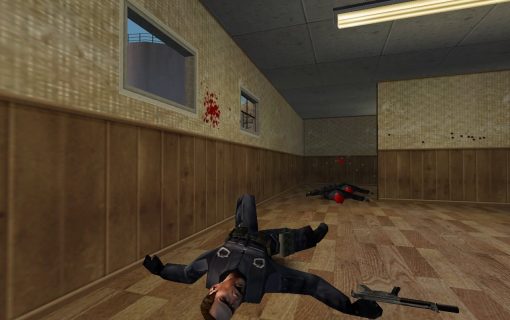
You also have a Map computer that lists your mission objectives and visually keys them with numbers to a live satellite video reconnaissance feed. Your binoculars have night vision and a digital compass, and they smoothly zoom out to very long ranges. Since much of the game is about stealth and careful observation, you'll get to use some clever gadgets in addition to your weapons. Weapon physics are generally believable: Automatic weapons have a noticeable kick that hinders your aim, and bullets will penetrate walls and doors of varying material and thickness depending on the caliber or muzzle velocity of the gun. Other real-world weapons in the game include the Glock 17, Desert Eagle, MP5, M16 A2, Minimi, Spas 12, Uzi, Jackhammer automatic shotgun, Dragunov sniper rifle, and others, along with flashbang and fragmentation grenades. They run the gamut from a combat knife for silent kills to antitank weapon for the occasional armored fighting vehicle. Unfortunately, there's no way to save games during a mission, and even on the lowest difficulty setting, some missions can be quite hard, and they will inevitably require the player to restart from scratch a number of times before achieving success.ĭuring missions, you'll have access to a large arsenal of weapons, some of which you're equipped with at the start of the missions, and many of which you pick up from dead guards. Also, the game sometimes cheats by making guards appear out of thin air or from buildings that you've already cleared. The abundance of guards is necessary because the game's enemy Artificial Intelligence is spotty if not downright poor, as enemies sometimes stand obliviously when you kill one of their comrades, who is only a few feet in front of them. Since Jones will typically be infiltrating military installations, he'll run into swarms of guards, many of whom stand waiting in towers with their sniper rifles. This is a strictly single-player game with 14 missions that are often large and complex, but they're divided into smaller, more manageable objectives. Jones health can be restored only by grabbing Medical Syringes from an infirmary, if there even is one in the area.

Even if Jones is wearing body armor, a few shots can still put a painful end to the hero's career. The game's general emphasis on realism means the player will need quick reflexes.

When Jones runs into the inevitable confrontation with guards, fast and furious firefights ensue. As such, he'll need to do a lot of creeping through the shadows, sneaking around security cameras, hacking computers to deactivate surveillance systems, and using binoculars to scout the area. The tone of the missions tends to be realistic: While David Jones is a skilled agent, he's just one man - not a one-man army. The narrative is primarily told through in-engine cutscenes at the beginning or end of each mission, and they're visually stylish - their dramatic camera angles and lighting effects approach film quality at times, though the flat dialogue amongst the characters can be tedious. By mixing military firefights with careful sneaking, the game manages to be entertaining overall, and the environments are very convincing. The missions feature a finely paced balance between tense stealth and dramatic combat. While none of the individual elements of Project IGI are particularly original, they're meshed together very well. It was followed up in 2003 by I.G.I.-2: Covert Strike. However it was praised for its superb sound design and graphics, thanks in part to its use of a proprietary game engine that was previously used in Innerloop's Joint Strike Fighter. Upon release the game garnered mixed reviews due to a number of shortcomings, such as poorly programmed Artificial intelligence, lack of a mid-game save option, and the lack of multiplayer features. If the odds get stacked too high against him, he can call in a napalm strike via his Map Computer. In order to counter its surveillance, bunkers, tanks, and gunships, Jones is equipped with NATO spy gear and assault weapons. The enemy's Artificial Intelligence will react to his every action and use military tactics to track his position. Jones has to sneak into the toughest military installations in Eastern Europe, and once inside, use his skills in thievery, computer hacking, sabotage, and reconnaissance to stop the madwoman. This first-person shooter emphasizes stealth and guile instead of massive firepower. Pursue and defeat a homicidal ex-Russian Colonel before she turns Europe into a nuclear wasteland in Project IGI: I'm Going In. It is one of the first computer games to feature realistic weaponry and tactical combat situations. Project I.G.I.: I'm Going In (released in Europe as simply Project I.G.I.) is a tactical first-person shooter developed by Innerloop Studios and released on Decemby Eidos Interactive.


 0 kommentar(er)
0 kommentar(er)
